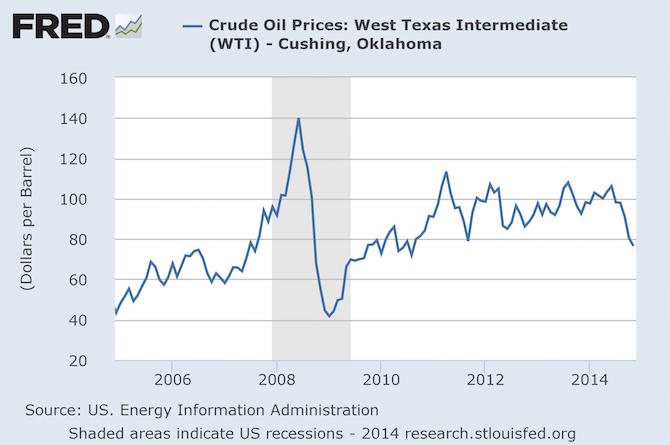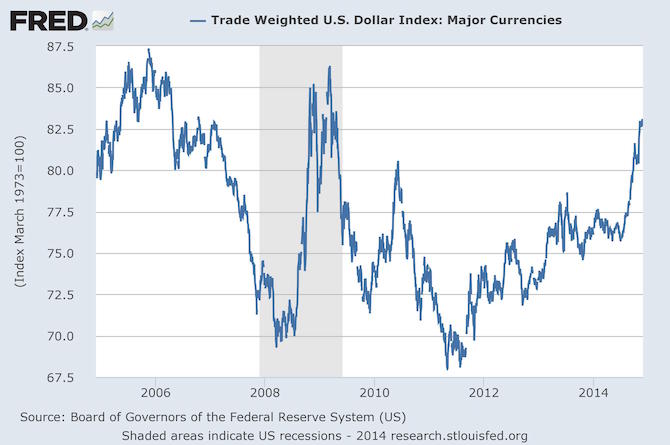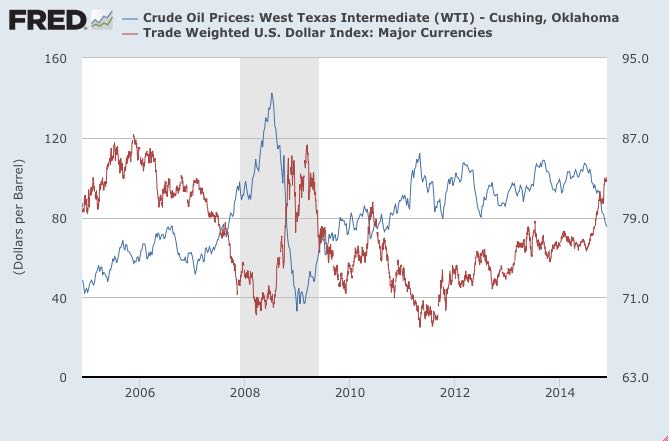QE, USD and the Price of Gas
Barely a decade ago, I lived in New York and would cross the George Washington Bridge to buy gas at prices below $1 / gallon. Then it crossed $2 / gallon and it seemed absurd! Before long, gas prices around or even above $4/gallon became the new normal. Nowadays, prices have dropped well below that - in many states it is below $3 / gallon - and the question of "what happened" has come up.
There is little doubt that the reduction in fuel prices is a "booster shot in the arm" to the economy. Driving to work is cheaper, public transportation (should be) cheaper, airlines can make more money, vacations cost less, transportation of basics like food and luxuries like iPhones cost less; in short, just about everyone wins.
While a lot of discussion on this topic has centred around production of shale gas in the US and Canada, I would like to look at a different perspective: the dollar.
To be clear: I do not believe the other factors, such as domestic production or Asian consumption do not matter, or matter less. I just want to focus on this one key area.
Oil is both imported and produced domestically, and trades on global markets. Even if it isn't imported, domestic oil will be exported if it can get more money overseas than domestically. Oil itself is priced in USD, usually with West Texas Intermediate (WTI) Crude as the gold-standard (if a commodity can be standardized by another commodity) benchmark.
Like any commodity that is globally traded, its price in one currency will depend not just on supply and demand of the commodity itself, but also on the relative strength of the currency purchasing it. If you want to buy a car made in Germany when the Euro is strong and dollar is weak, it will cost you a lot more dollars than when the dollar is strong and Euro is weak. Actually, it doesn't matter that much where it is manufactured, since they can always ship it elsewhere if your currency's offering is too low, thus driving the price up (assuming the manufacturer can ship it around at will).
So what has oil looked like for the last 10 years? According to the St Louis Fed, which is pretty reliable, the spot price for WTI looks like this:
Why did I pick 10 years? It was long term enough to show the trend and short term enough not to get lost in data overload. Anyone can go to the Fed's research page to create their own graphs. All of the graphs on this page are 10-year graphs with data points mapped each Friday.
As we can see - and have heard on the news and, more importantly, felt in our wallets every time we fill up - oil was pretty low 10 years ago, has been steadily climbing for years with some whipsawing in 2008-2009, and finally appears to be dropping in the last few months.
OK, now what has the USD been doing during that time? Thanks again to the Fed's excellent research department, here is a trade-weighted average of the USD vs a basket of foreign currencies. It basically shows how the dollar is doing versus our trading partners, which is what counts. We cannot just measure against the Euro or the Canadian Dollar or the Yen, because that would show only the value vis-a-vis that currency, which may have its own reasons for suddenly rising or falling. A trade-weighted basket is one of the best ways to see how the currency is doing overall.
That has been pretty volatile, too, and it isn't too surprising. The financial crisis of 2007-2008 put a real dent in the value of the dollar, which picked up a bit as everyone else suffered the crisis. It has been picking up significantly - almost to its highest point in a decade - since the Fed stopped QE and has been talking up that it is done.
What happens when you put the two together? You get the following (WTI on the left, USD on the right):
Minus some relatively short-term effects, the majority of the change in price of oil - and hence all of its byproducts like gas and jetfuel, as well as things that depend on it like, well, everything - can be explained by the strength or weakness of the dollar. When the dollar is strong, oil is cheap; when the dollar is weak, oil is expensive.
I do not know and cannot judge if the ballooning of the Fed's balance sheet as it pumped trillions into the economy for the past several years helped or hinder recovery. We have no control group to prove one way or another.
I can say, based on the above data, that the Fed's actions - probably combined with governmental deficit spending - weakened the dollar and made our gas, travel, food and just about everything more expensive.
It is amazing what 2 little graphs put together can tell you.


